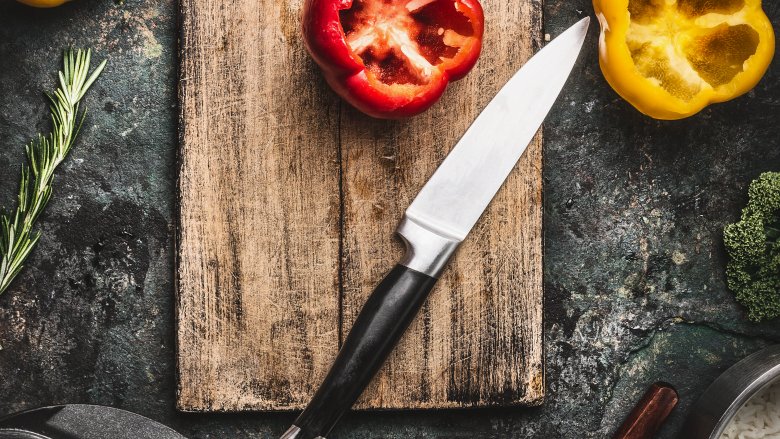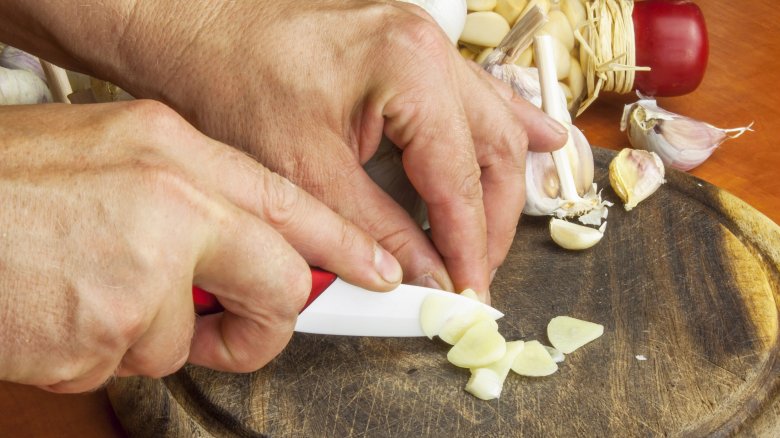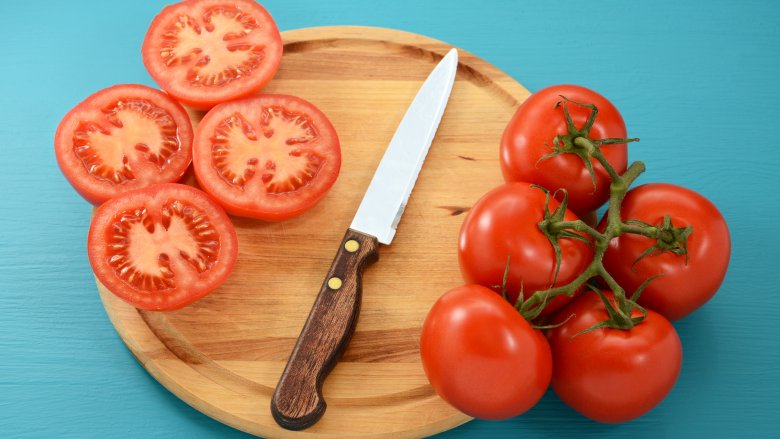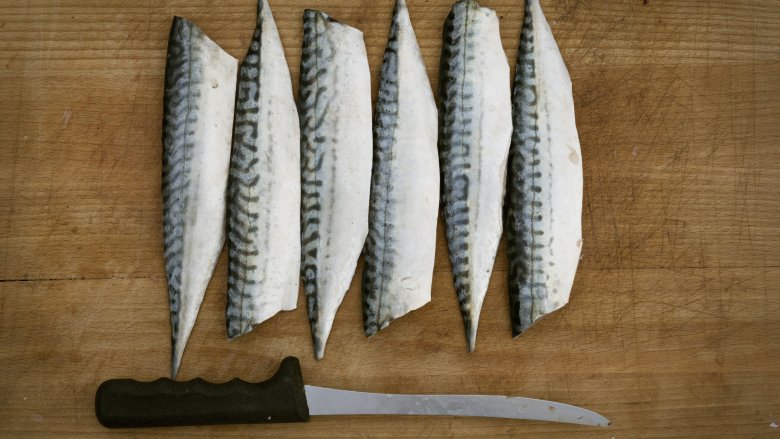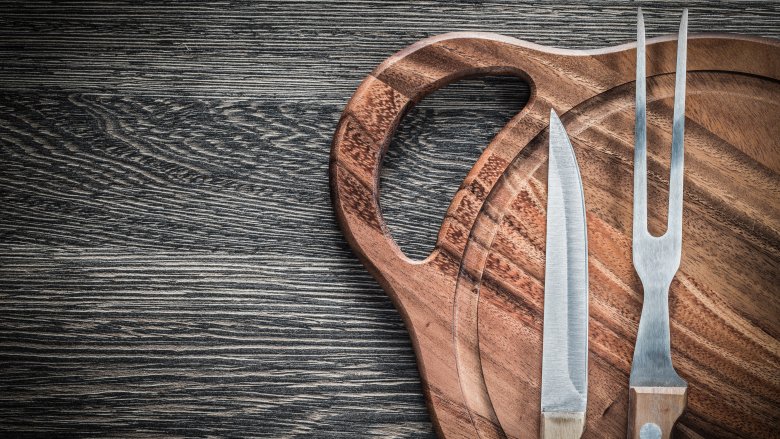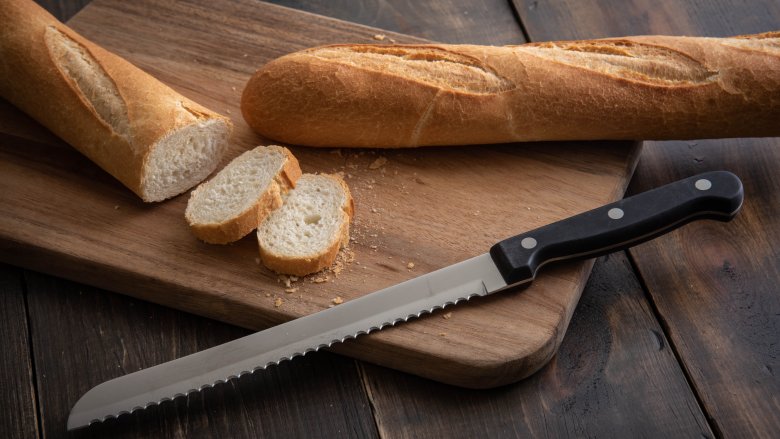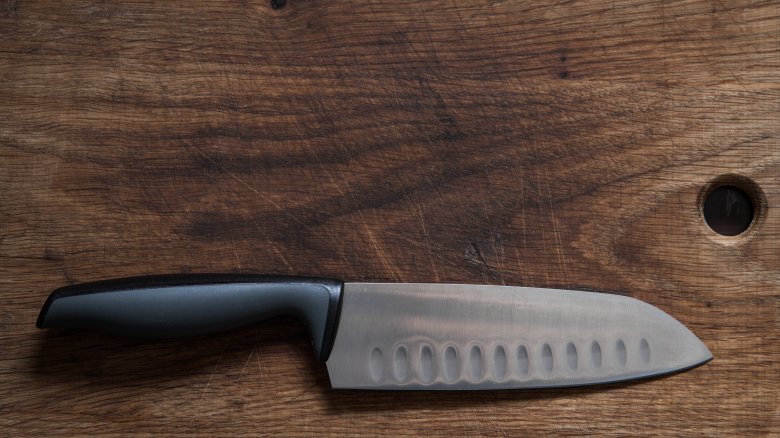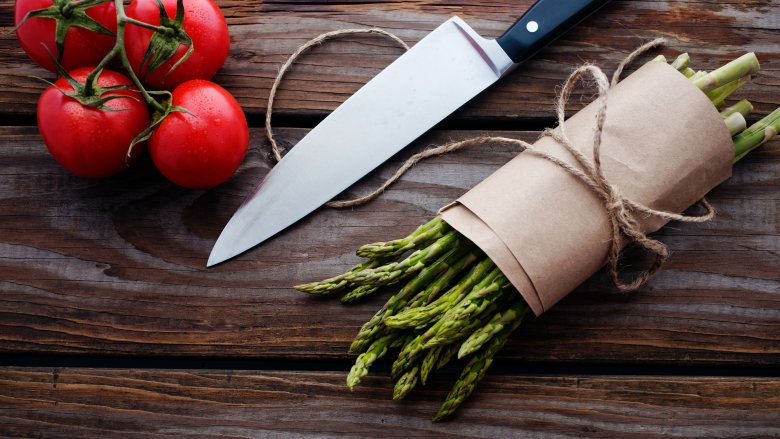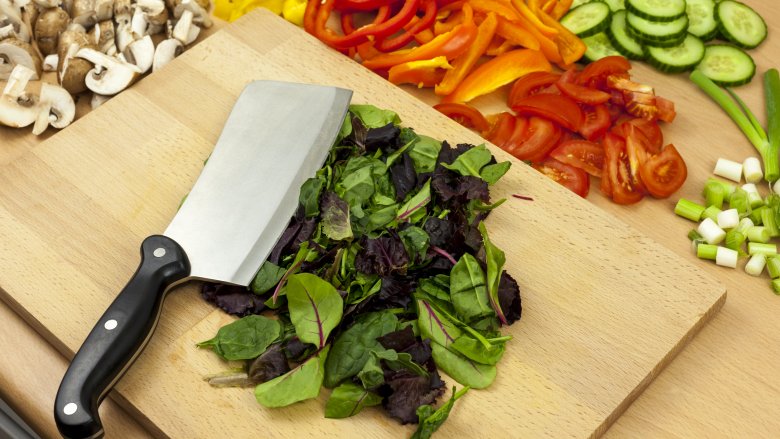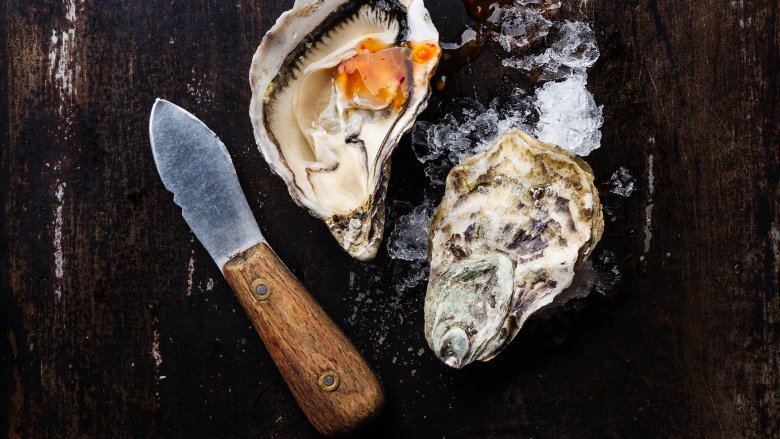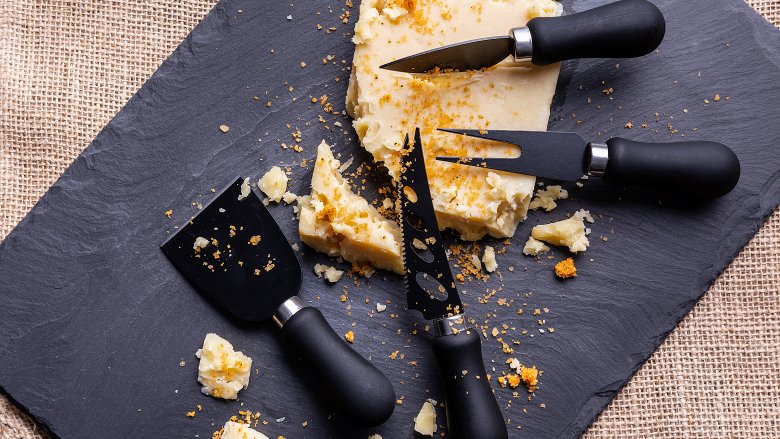You're Probably Using The Wrong Knife — Here's Why
It's an easy habit to fall into: you're prepping or cooking, you need a knife, and you grab the same one you always do. You might even wonder why the heck you have so many, because you never use them. Why, when one — probably your chef's knife — is so versatile?
Sure, it might get the job done, but there's a good chance it might be making that job harder — and who wants that? There's a reason that many chefs count their own, personal set of knives as among their most treasured possessions, and that's because a good set of knives used correctly can keep prep work from becoming a time-consuming, monotonous chore.
Picking the right knife for the job is going to make your work much, much easier, and once you break the habit of reaching for the same knife over and over again, you'll wonder why your other ones sat for so long.
Paring knife
The small-bladed, small-handled paring knife might look like a smaller version of your chef's knife, but Cooking Light says it's designed that way for a reason. That small blade and handle makes it easy to hold and use without a cutting board, and that means it's perfect for any cutting that needs precision and a light touch.
A good rule of thumb is that if you have to squint a little bit when you're working, that's a perfect job for a paring knife. Use it to de-vein shrimp, to cut the stems off fruits, to get thin ribbons of zest, for segmenting citrus fruits, or for mincing small things like a clove of garlic or a shallot.
Anything you need to trim or clean — think those weird bits on a potato — is also a job for a paring knife, and it's also perfect for scoring. Plated notes whether you're scoring the surface of a meat you're braising or the top of a pie, this is your go-to knife. Sometimes scoring is more decorative than functional, and the easy-to-hold, easy-to-control paring knife is perfect for fine detail work.
Serrated knife
Technically, says Soho Knives, the serrated knife is a type of paring knife. If you have both, though, this one's handy enough that it deserves to stand on its own.
The serrated blade means you're going to be cutting with more of a sawing motion than a non-serrated paring knife, so here's the general rule of thumb: if what you're cutting is hard on the outside and soft on the inside, use the serrated blade.
Those are things like tomatoes, bread rolls, and baked phyllo dough, and it's also perfect for citrus fruits if you're cutting through them without peeling them first. The serrated blade lets you cut through the tough outside without applying a ton of pressure and smashing the insides of whatever food you're working with. And since the serrated knife is the same small size as the regular paring knife, it's also going to be easier to use even after that first cut through, say, a grapefruit, when your hands are slippery from the juice. (Although remember, don't forget to clean the blade immediately — you don't want to leave anything super acidic on your knife.)
Fillet/boning knife
A filleting knife is, Soho Knives notes, a subset of boning knives so we'll talk about them together.
Generally, long boning knives taper to a point (although they can be curved or straight, rigid or flexible) that makes them perfect for separating meat from bone. Think of prepping chicken: these knives are prefect for separating the bones, slicing around the joints, and they're also great for pulling off any skin.
Filleting knives are generally a flexible kind of boning knife. That's so they can adjust to the shape of a fish while slicing along the spine, to fillet, or to skin. Since they're so delicate and relatively small, they're great for making precise cuts — and when you want your fish to look the best, that's exactly what you want. Wusthof notes that filleting blades can also be used for slicing super-thin pieces of fish, and let's be honest: using the right knife makes prep so easy, you might just find yourself actually cooking fish more often.
Slicing/carving knife
The slicing — or carving — knife is the one that might only come out at the holidays, but according to the Independent, it's one of the most underused knives in your arsenal.
It's not just great for slicing up a turkey, but it's perfect for any meal where you're cutting a hunk of meat into slices. It's what you want when you're getting ready to carve a ham, smoked salmon, or roast beef, and if you're going to be turning any piece of meat into slices for sandwiches later, this is definitely your knife. It seems like sort of a niche knife, but in order to be good at this very important job, it had to be designed specifically — to be long, straight, and narrow. It's the difference between "sawing" and "slicing", and they suggest this knife is important for other reasons, too.
Since it's the knife that comes out at the holidays, it's the knife that's front and center during some pretty important moments. It's a part of traditions, and it's the perfect knife to invest in, care for, and pass down through the generations.
Bread knife
Bread knives. They're for bread, right? Yes, but not exclusively. These long, serrated blades are perfect for cutting through both the hard crust of bread and the softer insides without destroying your loaf or your slice, but The Kitchn points out that they're good for other things, too.
Now, you're familiar with the small-bladed, serrated tomato knife, right? If you're working with large tomatoes (think the massive ones from your garden or the farmers market), your bread knife will work wonders with them. Slicing tomatoes for a sandwich? This is the knife you want for smooth, even slices. Use the same tough-outside, tender-inside rule for deciding what fruits to use your bread knife with. If there's a bit of a snap then tender flesh inside — think peaches — use your bread knife.
Bakers might find their bread knives invaluable for prep work in addition to sawing through the final product. The next time you need a block of chocolate turned into delicious shavings or morsels, grab your bread knife. It should be your birthday go-to, as well: it's perfect for cake, as well as hand pies, regular pies, and anything else delicate and doughy.
Utility knife
The utility knife is a bit of an oddball. It's shaped like a paring knife or a chef's knife, but it's somewhere in between the two when it comes to size. It's too big for the delicate work a paring knife does, and it's too small for the heavy lifting a chef's knife is capable of. So... what's the point?
It's actually great for a wide range of tasks, says The Kitchn, and if there's one general purpose knife you should default to, it's probably this one. It's heavy enough to be able to cut through sandwiches and paninis easily without being unwieldy, and it's also great for cutting mid-size fruits and vegetables like apples and carrots.
Have a cheese-and-meat plate you're putting together? Grab this knife for everything from hard blocks of cheeses to salami, pepperoni, and smoked meat. Basically, this is the only knife you need for most of your lunches!
Santoku knife
The Santoku knife is a sort of general, all-purpose knife that's similar to a chef's knife. There are a few key differences, though, and according to Kamikoto one of the most important is that a true, Japanese-crafted Santoku knife is usually made thinner and slightly smaller to allow for more precise work.
Santoku knives have a straight edge instead of a curved tip (which forces you to forgo the rocking motion you use with a chef's knife), but their thin blades allow for much finer cuts than you'd get with a regular chef's knife. They also tend to only have one single bevel (instead of the double beveled blade of most chef's knives), which means they tend to be much sharper.
"Santoku" means "three virtues," and think of those when you're deciding whether or not you need this one. The "virtues" are dicing, mincing, and slicing, but this knife particularly excels when you want to cut something into very, very thin slices. Meat, cheese, seafood, fruits, nuts... this knife does it all, and there's another bonus here, too. Anyone with smaller hands who find a chef's knife unwieldy can replace it with a Santoku.
Chef's knife
The chef's knife is probably your all-purpose, go-to knife, and while there's a ton of things it can do, there's some things it can't do.
What don't you want to use your chef's knife for? According to Kamikoto, you shouldn't be using it for slicing bread, cutting through dense meats, cutting through bones, anything frozen, or any tasks that require some serious precision cuts.
What's left? Use your chef's knife for dicing vegetables, herbs, and nuts (but fine cuts and julienning veggies should be left to another knife). They also say that the tip of the chef's knife makes it more than capable when it comes to disjointing some types of meat, particularly chicken. Think of your chef's knife as a sort of jack-of-all trades. It can technically do a lot of things, but it might not be the best tool for the job. It's versatile, sure, but once you get the hang of stopping for a moment to see if there's a better knife for the job, you might be surprised at just how often you end up reaching for something else.
Vegetable cleavers and meat cleavers
First, a vegetable cleaver. It's a small sort of cleaver Bon Appetit says you can use for everything from cracking a lobster shell to cutting open a pineapple or coconut to dicing herbs. Best of all? That wide, flat blade makes transferring whatever you just sliced up a piece of cake. (Don't use it on cake.) Cook's Illustrated says that the flat, thin, taped blade comes in two styles: a Chinese vegetable cleaver is a little more versatile, and can be used for slicing vegetables, mincing herbs, slicing boneless meats, and crushing things like garlic. A Japanese vegetable cleaver looks a bit like a rectangular santoku, and you're only going to be using that one only for vegetables.
While vegetable cleavers are hugely popular and versatile, Cook's Illustrated found that meat cleavers have generally fallen out of favor in most places. They're heavy, unwieldy, and they're definitely not good for fine work. The only reason you might want to invest in a meat cleaver is if you do a ton of breaking down full chickens or other massive slabs of meat and don't want the wear and tear on your other knives. Otherwise, just get a vegetable cleaver.
Fishy specialty knives
If you're the type that likes to entertain on a small or large scale — or just make an occasional, super-special dinner for your family — you might want to invest in some very particular knives, especially if there's seafood involved.
Whenever sushi is on the menu, you're going to want a knife capable of cutting thin slices easily. According to O Ya sushi chef Tim Cushman (via The Strategist), ceramic knives are the way to go. The fish won't to stick to them, you're not going to tear the piece you're working with, and they'll stay sharp for a long time. They can chip, so they'll take a little extra care, but they're super affordable and great for the delicate work sushi requires.
Oysters can be a challenge, but pick up an oyster knife and you'll find it makes shucking them so much easier, you might even be tempted to have them more often. (Get one with a rounded tip, because slips and slides happen to the best.)
The different types of cheese knives
Not all cheese were created equal, and neither were all cheese knives. Fortunately, Castello Cheese has some tips that make it simple.
Those cheese knives with the holes in them are actually for soft cheeses that might stick to a solid blade. Cheese cleavers — the ones that look like tiny meat cleavers — are best used on hard cheeses when you want a wedge or a chunk, not a slice. For slices of hard cheese, use a cheese plane. It's not exactly a knife, but it'll make the task so easy you'll wonder why you ever tried to use a regular knife to slice cheese.
Schuman Cheese adds that if you're partial to Gorgonzola and bleu cheese, there's a special knife for that — a Gorgonzola knife. The sharp blade cuts nicely, but the rounded tip spreads it just as easily. You may also want to invest in a cheese fork (for holding the block while you cut), and a rind cutter for, obviously, cutting cheese rinds.
